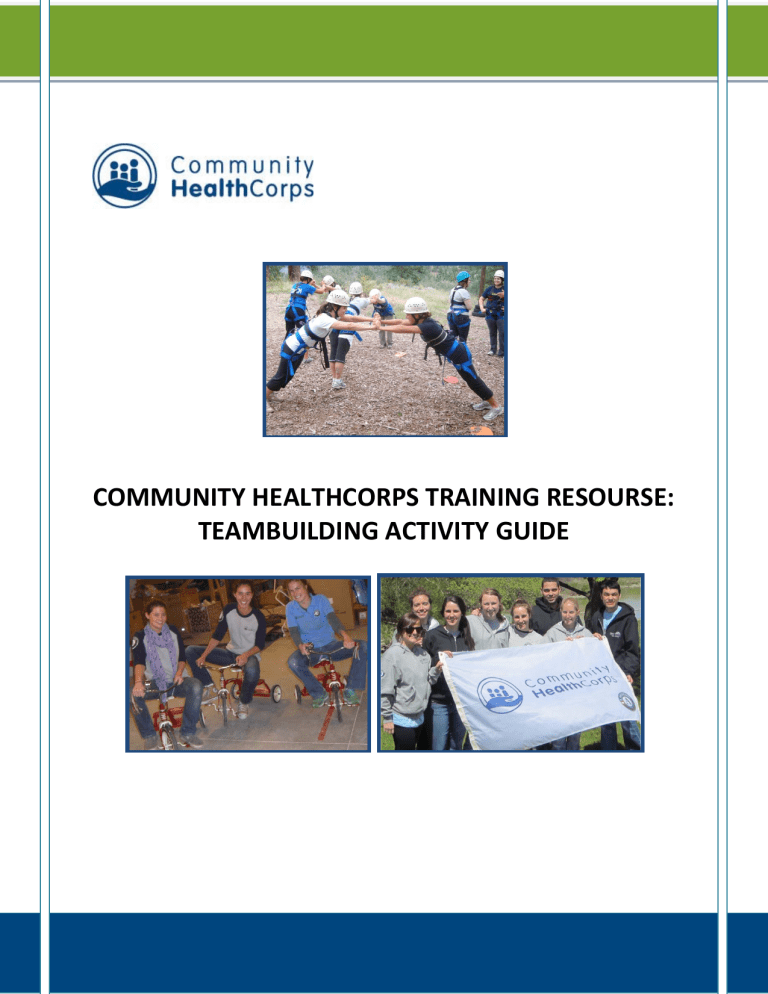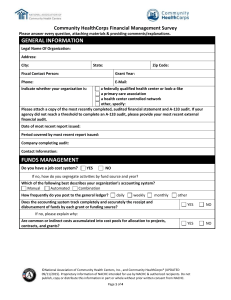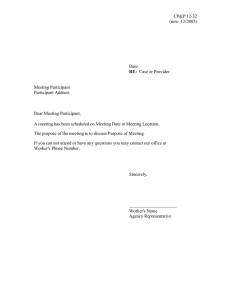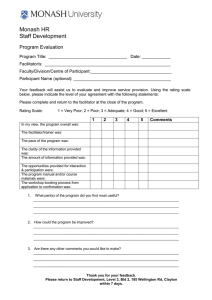Team-Building Activity Guide

COMMUNITY HEALTHCORPS TRAINING RESOURSE:
TEAMBUILDING ACTIVITY GUIDE
Teambuilding Activity Guide
The purpose of this resource is to provide Community HealthCorps Program
Coordinators with ideas on engaging their Community HealthCorps Navigators in teambuilding, inspiration and reflection focused activities. These activities aim to build a cohesive Community HealthCorps team, encourage an inspirational and open service environment and allow each navigator to reflect upon their term(s) of service.
TABLE OF CONTENTS
©National Association of Community Health Centers, Inc., and Community HealthCorps® (UPDATED
07/30/2012). Proprietary information of NACHC intended for use by NACHC & authorized recipients. Do not publish, copy or distribute this information in part or whole without prior written consent from NACHC.
Page 2 of 11
WARM UPS & ICE BREAKERS
Penny Play
Duration: 2-5 minutes
Participants: At least 2
Best Use: Short warm-up before a training or a meeting
Materials: Pennies, or coins (one coin for each participant, facilitator should try to find coins with recent years or at least years occurring after all of the participants were born)
Description: Each person gets a coin and looks at the year on the coin. One by one each person shares something significant that happened to him or her during that year.
Zen Counting
Duration: 2-10 minutes
Participants: At Least 2
Best Use: Short warm-up before a training and /or a meeting
Materials: None
Description: The participants will work together as a team to count from 1 to 10 (or any given number) out loud. Each person must say at least one number, in consecutive order. If more than one participant says a number at the same time, the group must start over. No participant can say a number consecutively more than twice. If the group is silent for more than 3 seconds they must start over.
Two Minute Artist
Duration: 3-5 minutes
Participants: At Least 2
Best Use: Short warm-up before a training and / or a meeting
Materials: paper, markers, crayons or colored pencils
Description: Participants will have 2 minutes to draw the person sitting to the right of them. After 2 minutes the drawing are shared. Facilitator should time the drawing process; all participants must stop after two minutes is up.
Mangy Cat (Broken Telephone on Paper)
Duration: 3-5 minutes
Participants: At Least 3
Best Use: Short warm-up before a training and / or a meeting
Materials: strips of paper, pencils or pens
Description: Each participant receives a strip of paper. At the start of the activity each participant draws anything they want on their strip of paper and passes it to the person on their right. Once each person receives the strip of paper passed to them, they must look at the picture, fold it over and write what they think is depicted by that picture. The strip of paper then gets passed to the right again. The next person looks at what is written on the folded strip of paper and draws what they think is written. When drawing or writing each person may only look at the most recent drawing or phrase. The game continues alternating by words and pictures until everyone has received everyone else’s strip of paper.
At the end of the game each person shares what was written/ drawn on their strip of paper.
©National Association of Community Health Centers, Inc., and Community HealthCorps® (UPDATED
07/30/2012). Proprietary information of NACHC intended for use by NACHC & authorized recipients. Do not publish, copy or distribute this information in part or whole without prior written consent from NACHC.
Page 3 of 11
Wrap Around
Duration: 5- 15 minutes (depending on the number of participants)
Participants: At Least 2
Best Use: This activity allows participants to get to know one another better
Materials: a long piece of string or yarn
Description: Each participant gets a turn holding the string. When a person gets their turn to hold the string he or she must slowly wrap it around their hand, while telling the other participants things about him or herself. If the person stops talking, he or she must stop wrapping the string until he or she starts talking again. The person can say anything about him or herself while wrapping the string (favorite color, age, the name of his or her school, favorite food, what he or she likes to do on weekends, etc). The string is unwrapped and passed on to the next person as soon as it is completely wrapped around the person’s hand.
Fort Building
Duration: 5-30 minutes (depending on the number of participants)
Participants: At Least 4
Best Use: This activity allows participants to get to know one another better
Materials: this activity needs to take place where participants will have access to nature (i.e.: sticks, leaves, grass, etc.)
Description: The Facilitator tells the participants that they have 2 minutes to collect as many items
(grass, sticks, leaves, etc) to build a fort as a team. Once the participants come back with their materials, the facilitator informs them that they will not be building a fort at all. Instead each person must share something about him or herself for each item they collected. For example if someone collected 8 items, he or she must share 8 things. This activity can also be done with leaves (or any collectable object), where the facilitator asks the participants to collect as many fallen leaves (or chosen object) as they would like for a mystery activity.
Who Would You Bring to Dinner
Duration: 5-30 minutes (depending on the number of participants)
Participants: At Least 2
Best Use: This activity allows participants to get to know one another better
Materials: paper, pens or pencils (markers, color pencils- optional)
Description: Each participant is told to imagine that they are hosting a dinner party and that they can invite any 5 (or any number of) attendees. Theses attendees can be dead, alive, famous, family members, imaginary, etc. The participants are also told that they can choose any location and any type(s) of food to serve at their dinner. Each participant is asked to draw or write their dinner party on the provided piece of paper. After everyone is done, each person shares the details of their dinner to the rest of the group.
©National Association of Community Health Centers, Inc., and Community HealthCorps® (UPDATED
07/30/2012). Proprietary information of NACHC intended for use by NACHC & authorized recipients. Do not publish, copy or distribute this information in part or whole without prior written consent from NACHC.
Page 4 of 11
Human Knot
Duration: 5-15 minutes (depending on the number of participants)
Participants: At Least 5
Best Use: This is a great icebreaker, but involves close proximity so make sure all of your participants are comfortable with getting up close to one another
Materials: NONE
Description: Participants start out standing in a circle facing each other, shoulder to shoulder. First each participant lifts their right hand and reaches across the circle and takes another person’s hand. Next the same is done with each person’s left hand. Make sure that no one standing next to one another is holding hands. Once everyone is “tangled,” the facilitator says go and the group works as a team to untangle without letting go of anyone’s hand. The end result should have all of the participants standing in a circle facing away from one another holding hands. If a participant lets go before everyone is untangled, the entire group must start over.
Zoom Questions
Duration: 2-10 minutes
Participants: At least 5
Best Use: This is a great icebreaker to use as a warm-up before trainings or meetings
Materials: NONE
Description: One participant starts off by asking a question that must have two set responses: such as a choice between two things: winter or fall, beach or mountains or a yes or no question. Once the question has been asked the participants go around in a circle and each person can answer with by picking one of the choices or by saying “zoom.” If a participant says “zoom” it means they do not want to answer the question and it moves on to the next person in the circle. The participants must answer quickly and move on to the next person. The person who asked the question answers it last. After everyone has answered the question, another person may ask a question and the game is repeated. It is up to the facilitator and the time constraint on how many questions are asked.
©National Association of Community Health Centers, Inc., and Community HealthCorps® (UPDATED
07/30/2012). Proprietary information of NACHC intended for use by NACHC & authorized recipients. Do not publish, copy or distribute this information in part or whole without prior written consent from NACHC.
Page 5 of 11
TEAM BUILDERS
My Favorite Song
Duration: 1-3 hours (depending on the number of participants)
Participants: At least 4
Best Use: The activity is best used for a team to get to know one another on a deeper level, and relate to one another’s past experiences and ordeals through music – (this activity requires prior preparation on the part of the individuals participating.)
Materials: Music Playing Device, Recorded version of songs (provided by participants), Printed out song lyrics (provided by participants)
Description: Each participant is asked to consider what his or her favorite song is and why. After they choose a song, they are asked to print out copies of the lyrics for this song for each participant. They are also asked to bring in a recording of this song, so that all of the participants may listen to this song. Each person takes a turn to play their song recording, while the other participants listen to it and view the lyrics. After a person’s song has been played, he or she explains to the group what the song means to them, why they chose it and why it is important to them (these questions can be altered for the facilitator’s purpose and preference).
Puzzle Pieces
Duration: 10-30 minutes
Participants: At Least 3
Best Use: This activity is best used for creating a team atmosphere/ understanding
Materials: Paper cut into blank puzzle pieces that fit together, blocks that fit together, any materials that can create the effect of multiple pieces fitting into a whole, writing utensils (to write on each piece)
Description: Each participant chooses or is given a puzzle piece and asked to think about what they will bring (or are already contributing) to the team. Once each person comes up with their contributing factor, they should write it on their given piece. After everyone is done, each person goes one by one and shares their piece and places it in the center. As each person shares the puzzle should be constructed until it is whole again. This activity should signify what each member will (or is already) bring to the team and that the team is much more effective as a whole (due to all of its contributing parts).
Team Time Capsule
Duration: 10-30 minutes
Participants: At Least 2
Best Use: This activity is best used for creating a team atmosphere/ encouraging a team legacy.
Materials: Construction paper, makers, colored pencils, glue, scissors
Description: The participants are asked to create a time capsule with objects that describe their journey together as a team. The focus should be around the legacy the team wants to leave for other people to find and/or what impact the team has or would like to create during their time together. The participants work together to create objects out of construction paper to glue to a drawn time capsule.
©National Association of Community Health Centers, Inc., and Community HealthCorps® (UPDATED
07/30/2012). Proprietary information of NACHC intended for use by NACHC & authorized recipients. Do not publish, copy or distribute this information in part or whole without prior written consent from NACHC.
Page 6 of 11
I’m on a Boat
Duration: 10-30 minutes
Participants: At Least 2
Best Use: This activity is best used during the mid-point of a team’s time together, to gauge how each member is currently feeling about being a part of the team and/or their performance within this team.
Materials: A poster size (optional) drawing of a boat on a body of water
Description: The drawing of the boat is placed in a central place. Each participant is asked to place him or herself on the boat/ off the boat (somewhere on the poster) based on how they are feeling as a part of their team. For example if a person is feeling like a team leader they would place themselves at the front of the boat, or if a person is feeling like they are on the outside of the team and/or overwhelmed they might place themselves as falling out of the boat. After each person is done drawing him or herself on the boat, everyone shares one by one where they are on the boat and why.
Portrait of My Journey
Duration: 30-40 minutes
Participants: At Least 2
Best Use: This activity is best used during the mid-point and/or end-point of a team’s time together, to gauge how each member is currently feeling about being a part of the team and/or their performance within this team.
Materials: construction paper, pencils, pens, markers, colored pencils, magazines, glue, scissors
Description: Each participant is asked to use the materials provided to draw/ express their journey within the team, (can also be their journey as a HealthCorps member). Participants can use any sort of expression to create their journey, and should be given at least 15 minutes to do so. After everyone has completed their “journeys,” each person shares with the group.
Skittles
Duration: 30-40 minutes
Participants: At Least 2
Best Use: This activity is best used for team members to get to know one another and/or find out about their goals, fears, etc., as HealthCorps members.
Materials: A large bag of skittles or multicolored M&Ms, strips of paper and/or pieces of paper (for the question bank)
Description: The facilitator must prepare this activity ahead of time, creating questions corresponding with the each color of piece of candy. The colors can either correspond with one question or categories of questions. For example the purple category can be questions about dreams (1. Where do you see yourself in 5 years? 2. What did you dream of being as a child 3? How does being a HealthCorps member fit into your future aspirations? ). To start the activity all of the participants sit in a circle and a bag of skittles is passed around. Each participant is told to take a couple of pieces and NOT eat them. After each person has pieces of candy, a participant is chosen or volunteers to go first, and answers a question corresponding with a color of one of his or her chosen skittles. Participants answer one question during each turn, the number of turns each person gets should be determined by the amount of time allotted for the activity.
©National Association of Community Health Centers, Inc., and Community HealthCorps® (UPDATED
07/30/2012). Proprietary information of NACHC intended for use by NACHC & authorized recipients. Do not publish, copy or distribute this information in part or whole without prior written consent from NACHC.
Page 7 of 11
My Moment in the Sun
Duration: 15-30 minutes
Participants: At Least 2
Best Use: This activity is best used during the mid-point of a team’s time together. This activity will allow teammates to reflect upon their best times within the team or individually (during their year of service so far) and share it back with their team. This will encourage a positive outlook on the rest of the team’s time together.
Materials: Paper (construction paper- optional), markers/ writing utensils, string/ yarn
Description: The facilitator will prepare pieces of paper by attaching string to them so they can be loosely hung around a person’s neck. Each participant will be given a piece of paper with string attached to it and a writing utensil. Each participant will be asked to think of a project, encounter, day that they are really proud of during their year of service (with their team or individually), and write about it on the provided piece of paper. After everyone has finished writing about “their moment in the sun,” each person should have the opportunity to share with the rest of team. After each person is done sharing the hang their piece of paper around their neck for the rest of the day (training), to remind one another about their positive experiences. At the end of the day the participants should be encouraged to hang their piece of paper at home in a visible place, so if they are having a tough time they can remember about their moment in the sun and become motivated again.
My Bag
Duration: 30-90 minutes
Participants: At least 3
Best Use: The activity is best used for a team to get to know one another on a deeper level, and relate to one another’s past experiences and ordeals by sharing personal items belonging to each team member
Materials: Will be brought in by the participants
Description: Each participant is asked (ahead of time) to bring in 3 (or 5) items that are meaningful to them. Each person shares their items, their meaning and significance with the rest of the participants.
Items can be shared all at once or each person can start out by sharing one item (depending of the facilitator’s preference and time constraints.)
Appreciation Circle
Duration: 10-20 minutes
Participants: At least 4
Best Use: This activity is best used to boost team morale and build team unity.
Materials: Construction Paper (optional- regular paper can also be used), markers/ colored pencils
(optional pen/pencil can also be used)
Description: The participants sit in a circle, facing one another. Each participant is given a piece of paper, and writes their name (in large font) in a visible spot on the piece of paper (preferable on top or in the middle). Each person passes their piece of paper to the person on the right of them. Once each participant receives a paper with someone else’s name on it, they are asked to write something they appreciate about the person whose name is on the piece of paper. This is repeated until all of the participants receive the piece of paper with their name on it.
©National Association of Community Health Centers, Inc., and Community HealthCorps® (UPDATED
07/30/2012). Proprietary information of NACHC intended for use by NACHC & authorized recipients. Do not publish, copy or distribute this information in part or whole without prior written consent from NACHC.
Page 8 of 11
DE BRIEFS & REFLECTION ACTIVITIES
Roses and Thorns
Duration: 5-10 minutes
Participants: At least 2
Best Use: This activity is best used to gauge how participants (team) are feeling after completing a training, an activity, a project, etc.
Materials: NONE
Description: This debrief is similar to pluses and deltas. The participants are asked to think of a rose, a positive experience/ thought that occurred during the activity, training, project, day, etc. Each person is also asked to think of a thorn, a difficulty, or something that they would like to change that occurred during the activity, training, project, day, etc. Once everyone has determined their rose and thorn, each person is asked to share both and explain their reasoning.
Shake It out
Duration: 5-10 minutes
Participants: At least 2
Best Use: This activity is best used to gauge how participants (team) are feeling after completing a training, an activity, a project, etc.
Materials: NONE
Description: All of the participants are asked to ball up on of their fists. The facilitator will call out
“shake it out,” and everyone shakes their fist. After several seconds, the facilitator will call out “1, 2, 3,” and on 3 each participant throws out a certain number of fingers from their fist. A 1 would signify that the participant is feeling very uncomfortable, negative or unhappy, and a 5 would signify that the participant is feeling confident, happy, excited, etc. Each person shares their number and why they chose it.
One Word
Duration: 5-10 minutes
Participants: At least 2
Best Use: This activity is best used to gauge how participants (team) are feeling after completing a training, an activity, a project, etc.
Materials: NONE
Description: Each participant is asked to choose one word (a noun or verb, try to stay away from adjectives as they can become generic: i.e.: good, bad, etc) to describe the activity, training, project, etc.
Once each person has chosen his or her word, everyone takes turns sharing their word and why they chose it. For example if a team was working on painting a fence, a word that might be chosen is
“dripping,” to describe how the person ran into the problem of dripping paint the entire day and had to come up with creative ways to prevent the paint from dripping onto the cement.
©National Association of Community Health Centers, Inc., and Community HealthCorps® (UPDATED
07/30/2012). Proprietary information of NACHC intended for use by NACHC & authorized recipients. Do not publish, copy or distribute this information in part or whole without prior written consent from NACHC.
Page 9 of 11
My Glass
Duration: 5-10 minutes
Participants: At least 2
Best Use: This activity is best used to gauge how participants (team) are feeling after completing a training, an activity, a project, etc.
Materials: paper, writing/ drawing utensils
Description: Participants are asked to draw a glass and fill it with a certain amount of liquid based on how they are feeling after completing a training, an activity, a project, etc. If a participant is feeling very positive about the activity he or she would fill their glass up entirely and vice versa. After each person is done, everyone is given the opportunity to share their glasses and explain the reasoning behind the amount of liquid in their glasses.
Zig Zag
Duration: 5-10 minutes
Participants: At least 2
Best Use: This activity is best used to gauge how participants (team) are feeling after completing a training, an activity, a project, etc.
Materials: paper, writing/ drawing utensils
Description: Participants are asked to draw a line representing the training, activity, project, etc that they have just completed. This line should represent how they felt at certain points of the activity, etc.
For example the line can be flat if they felt “fine about it,” or if can go up or down when they felt great or experienced difficulties. Each person’s line should resemble a line chart representing their feelings throughout the activity they are debriefing one. After everyone is done creating their line, each person should have the opportunity to share their line and their reasoning behind it.
Pick A Quote
Duration: 5-10 minutes
Participants: At least 2
Best Use: This activity is best used to gauge how participants (team) are feeling after completing training, an activity, a project, etc or during a certain point within their service. This activity strongly depends on the quotes selected; facilitators should take care to select relevant quotes depending on the particular reflection topic.
Materials: a variety of positive/inspirational quotes on strips of paper (one quote per strip of paper)
Description: Participants are asked to select a quote that strong resonates with him or her based on the specific reflection topic/ training/ day, etc. Each participant takes turns to explain why he or she selected a particular quote and how it relates to the topic of discussion.
©National Association of Community Health Centers, Inc., and Community HealthCorps® (UPDATED
07/30/2012). Proprietary information of NACHC intended for use by NACHC & authorized recipients. Do not publish, copy or distribute this information in part or whole without prior written consent from NACHC.
Page 10 of 11
ADDITIONAL RESOURCES
Leadership & Diversity Trainings:
http://bonnernetwork.pbworks.com/w/page/22362744/Index%20of%20Trainings%20by%20Skills http://www.workshopexercises.com/Leadership.htm
Team builders:
http://www.teampedia.net/wiki/index.php?title=Main_Page http://wilderdom.com/games/ http://www.oakharborcheer.com/TeamBuildingGames.html http://www.teambuildingportal.com/games http://www.ultimatecampresource.com/site/camp-activities/camp-games.html
Inspirational Quotes: http://www.energizeinc.com/reflect/quote1s.html http://www.inspirational-quotes.info/ http://beyondthequote.com/
©National Association of Community Health Centers, Inc., and Community HealthCorps® (UPDATED
07/30/2012). Proprietary information of NACHC intended for use by NACHC & authorized recipients. Do not publish, copy or distribute this information in part or whole without prior written consent from NACHC.
Page 11 of 11




